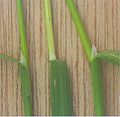| Poa annua | |
|---|---|
 | |
| Scientific classification | |
| Kingdom: | Plantae |
| Clade: | Tracheophytes |
| Clade: | Angiosperms |
| Clade: | Monocots |
| Clade: | Commelinids |
| Order: | Poales |
| Family: | Poaceae |
| Subfamily: | Pooideae |
| Genus: | Poa |
| Species: | P. annua |
| Binomial name | |
| Poa annua | |
Poa annua, or annual meadow grass (known in America more commonly as annual bluegrass or simply poa), is a widespread low-growing turfgrass in temperate climates. Notwithstanding the reference to annual plant in its name, perennial bio-types do exist. [2] This grass originated as a hybrid between Poa supina and Poa infirma . [3] Major chromosomal rearrangements after polyploidy have contributed to variation in genome size in Poa annua. [4]
Contents







